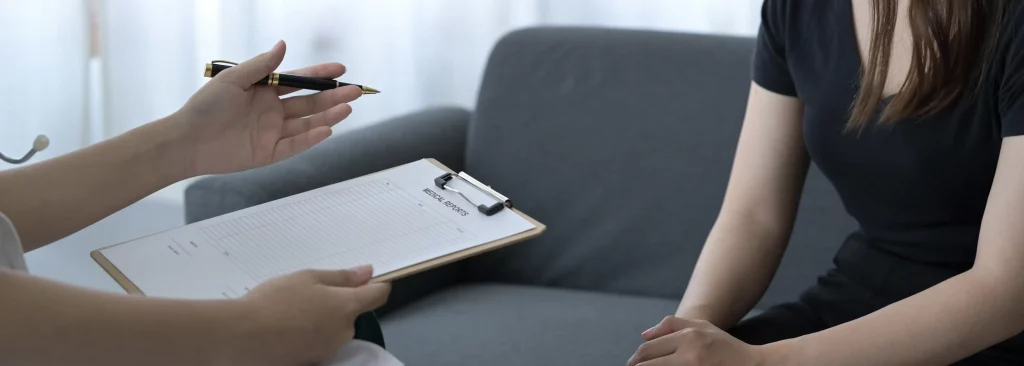Medication-Assisted Treatment
People struggling with addiction and mental health symptoms, as well as their loved ones, often find themselves lost. But navigating the complex topic during substance-related physical and emotional turmoil seems impossible. Temporary relief from the drug’s influence can provide the space to break the cycle.
Medication assisted treatment in Riverside, California, can provide that space, giving struggling people a chance to heal. When carefully administered during a detox treatment and therapy program, medications can be highly effective in breaking the cycle of addiction. It relieves the physical symptoms and psychological cravings that drive the urge to use. Thus, making it easier to maintain a commitment to sobriety.
Medication is often used to treat opioid use disorders OUD among people with a long history of abusing opioid drugs. It is a relatively standard treatment option offered by many opioid treatment programs.
As part of our individualized treatment programs, Everlast’s Riverside medication assisted treatment center provides a comfortable space for safer opiate withdrawals. Our singular goal is to improve recovery outcomes and prevent harm to people with substance use disorder. With medication-assisted therapies, holistic modalities, and psychoeducation services, we help clients improve their chances of long-term recovery.
What Is Medication-Assisted Treatment?
The Substance Abuse and Mental Health Services Administration (SAMHSA) describes medication assisted treatment (MAT) as the use of medications to treat substance use disorders. They also stress the importance of doing so in the context of counseling and behavioral therapies, creating a whole-patient approach. Their purpose is to improve recovery outcomes for patients struggling with addiction, primarily alcohol use disorder or opioid dependence.
Medication-assisted treatment for opioid use disorders can help people physically detox from the drug and start counseling. Preventing further harm to people with substance use disorders is the primary goal.
In some cases, the medication must serve as a safer substitute for the drug the patient is addicted to. This removes many physical challenges to staying sober, giving the patient a stronger position to resist psychological and emotional temptations. Other times, the medication blocks the desired feeling and effect of the addictive substance, reducing its influence over the user.
From a stabilized condition, it’s much easier to work with the patient to begin handling the issues that motivate addiction. Treatment programs like Everlast combine medications with treatments, including support therapy and psychoeducation, to secure a lasting recovery. Our staff knows the importance of full-spectrum support for improving recovery outcomes for opioid addiction treatments.

The Benefits of MAT
When used effectively, MAT helps to ease the detox process while more quickly returning the user to a normal state.
MAT is used to counter the effects of opiates or alcohol with a system-wide approach, including:
- Stabilizing brain chemistry
- Reduction in the physical effects of opioid and alcohol addiction
- Relief of psychological cravings
- Return of bodily functions to normal
- Countering the euphoric effects of the drug
Common Medications used in MAT
When used effectively, MAT helps to ease the detox process while more quickly returning the user to a normal state.
MAT is used to counter the effects of opiates or alcohol with a system-wide approach, including:
- Stabilizing brain chemistry
- Reduction in the physical effects of opioid and alcohol addiction
- Relief of psychological cravings
- Return of bodily functions to normal
- Countering the euphoric effects of the drug

Buprenorphine
While an opiate, buprenorphine works differently in the brain than other opiates. It binds to the brain’s opiate receptors but stimulates them less than other opiates, resulting in fewer pleasurable sensations driving addiction.
Keeping the brain’s opiate receptors busy prevents other, more powerful opiates from binding with them. Opioid receptors are rendered partially inactive, meaning the risk of overdose is decreased. Therefore, the urge to use more damaging substances is diminished.
Buprenorphine works by slowing withdrawal symptoms while reducing cravings for the more addictive substance. Careful use of buprenorphine is effective and has low abuse potential when used as prescribed, but it is a short-term solution. The medication may be given as a strip that dissolves in the mouth, by injection, or with an under-the-skin implant.
Side effects of these mat medications resemble those of opioid use disorder, including:
- Constipation
- Nausea and vomiting
- Drowsiness
- Dizziness
- Blurred vision
- Impaired attention
Due to its potential for abuse, buprenorphine is often combined with other medications, as explained below.

Naltrexone
Naltrexone is not an opiate – it is an opiate antagonist, meaning it blocks the action of opiates in the brain. Because it contains no opiates, naltrexone carries no risk of physical dependency. Naltrexone stops opiates from functioning by attaching to opiate receptors, blocking them from receiving any opiates. If someone uses opiates after taking naltrexone, they will not experience the desired feelings, temporarily reducing the addiction cycle.
In addition to binding with opiate receptors, naltrexone removes any opiates currently attached to them. This will cause immediate withdrawal for those receiving naltrexone with opiates in their system. Naltrexone is often given immediately upon completion of a detox program. Clients must be off opiates for several days before receiving them.
Naltrexone is available under the brand name Vivitrol. A monthly injection prevents opiates from working in the person’s brain for an entire month. Side effects of naltrexone that SAMHSA has reported include:
- Headache
- Joint pain
- Trouble sleeping
- Muscle cramps
- Nausea
- Dizziness

Combined Medications
An FDA approved medication, such as Suboxone, contains buprenorphine and naloxone (related to naltrexone). These dual medications provide withdrawal symptom relief and ease cravings with buprenorphine while lessening the effect of opiates with naloxone. Instead of buprenorphine alone, many facilities use Suboxone and other combination medications to increase effectiveness and decrease potential misuse.
What Types of Medications Does Everlast Use?
At Everlast Recovery Centers, we strive for complete abstinence for all our clients. However, we recognize that all clients have unique needs and circumstances.
Sometimes, it would cause more harm to cause patients to endure extreme withdrawals, mainly when they can only be lessened with the safe use of medications. Our expert medical professionals and trained clinical staff will help determine the best course of treatment.

Our preferred medication treatment method is using naltrexone in the form of Vivitrol. Since neither naltrexone nor Vivitrol is an opiate, it does not activate any opiate receptors, meaning no potential for misuse exists. With no potential for addiction or dependence and no risk of overdose, naltrexone offers safe, effective treatment for people recovering from opiates.
Under certain circumstances, people may require treatment facilities with buprenorphine or a combination medication like Suboxone. While buprenorphine keeps opiate receptors calm without producing a high, it still holds the potential for increased tolerance levels. Due to its addictive potential, we prefer naltrexone whenever possible. All decisions we make regarding MAT are made under the care and direction of our expert medical team.
We also apply MAT in the context of the patient’s individualized care program because we emphasize the Treatment aspect of MAT. At Everlast, we stay true to our primary goal of keeping our clients safe while providing dedicated, client-centered care.
Every client who walks into our facility is treated as a unique person. And we take MAT interventions with the utmost care and attention. We are committed to your recovery, and we ensure you are supported throughout your treatment with us.
Medication-Assisted Treatment in Riverside, California
We provide expert and conscientious therapy to people in the greater Riverside area. With a 3:1 patient-to-staff ratio, you’ll receive the highest level of care and attention in a safe and comfortable domestic setting. Having been there himself, Everlast’s owner and founder knows firsthand how vital close connections are to facilitating the recovery process.
Everlast Recovery Centers is located in Riverside, California, serving riverside and the greater Los Angeles area. We’re here for local customers needing mental health and addiction treatment services, providing a full suite of therapeutic modalities. Our MAT services are sensitive to opioid use disorders with co-occurring conditions. And we provide the broadest spectrum of support possible.
We treat recovery’s emotional, mental, and physical needs through a synthesis of evidence-based traditional and holistic therapies. The needs of those addicted to opiates and other substances can feel beyond one’s reach when going it alone. However, we prove to each patient that recovery isn’t just possible with the proper community support – it’s inevitable.
For more information or to inquire about admissions to our Riverside, California, MAT programs, and change your life today!

